Health & Education
We all want the best care possible for our horses. The Heath & Education section covers both Learning Institutions, Organizations as well as many sources for equine assistance including Veterinarians and Farriers.
For those who want a to formally study horses, the Education section includes College Riding, Equine Studies, and Veterinary Schools. Learn about the wide variety of horses in the Horse Breeds section. Supplements and Treatments Therapy are also included in the section.
Everyone can learn from Fine Art and there are some specialty Museums that might surprise you.
Horses as a therapy partner enrich the lives of the disabled. These facilities are listed in our Therapeutic Riding section. To help children and young adults build confidence and grow emotionally, please see the resources available on the Youth Outreach page.
Looking for a place to keep your horse? You can find it in the Horse Boarding section. Traveling? Find a Shipping company or Horse Sitting service if your horse is staying home!
Want to stay up to date with the latest training clinics or professional conferences? Take a look at our Calendar of Events for Health & Education for the dates and locations of upcoming events.
Do we need to add more? Please use the useful feedback link and let us know!
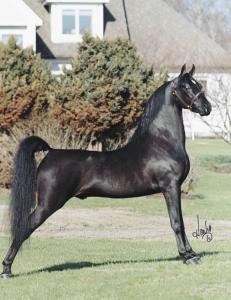
Courtesy of the American Morgan Horse Association
In 1789, George Washington became the first president of the United States and the U.S. Constitution was signed into law. That same year in Springfield, Massachusetts, a small bay colt named Figure was born. This colt was instrumental in building the new country and founded America's original equine breed, the Morgan.
The Morgan was the first recognized horse breed in the United States. It is the official state animal of both Vermont and Massachusetts. Other breeds have claimed existence in colonial times, but today only the Morgan can trace his bloodlines to a common ancestor. The Morgan has influenced other breeds, including Tennessee Walking Horses, Quarter Horses, Standardbred, and American Saddlebreds.
The Morgan horse is easily recognized by his proud carriage, upright graceful neck, and distinctive head with expressive eyes. Deep bodied and compact, the Morgan has strongly muscled quarters. His intelligence, willingness, zest for life, and good sense is blended with soundness of limb, athleticism, and stamina. In addition, Morgan thriftiness and longevity have made this breed a good bargain for more than 200 years.
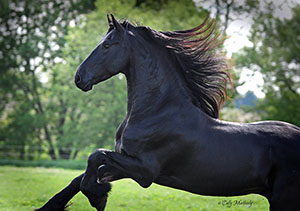
The Friesian horse is truly a unique breed, developed from a very old breed which was inherent to all of Western Europe. It's native to The Netherlands. Historically speaking, the Friesian horse has been influenced by eastern bloodlines and has often been threatened with extinction. Thanks to the single-mindedness and dauntless dedication of true horse lovers, one can still appreciate the many facets of the Friesian horse today.
Always black, with thick flowing mane and tail, large in stature, with substantial bone, this horse is the proverbial “ black stallion. “ Many little girls grew up dreaming about such a horse!
Friesians are a very old breed of horse, having been developed in the north province of Friesland, in the Netherlands centuries ago. Used as draft animals, as well as cultivated to become the wealthy owner’s high stepping carriage “Sunday Horse”, the breed is very much a national treasure of the Netherlands.
Read more: Big, Black and Beautiful! The History of the Majestic Friesian Horse
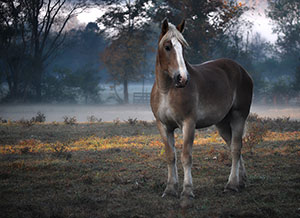
(Washington, DC) - The Unwanted Horse Coalition (UHC) released new policies and procedures for organizations wishing to host no- or low-cost gelding clinics through the Operation Gelding program. The new policies take effect January 1, 2017, and applications for 2017 clinics are now being accepted.
The UHC voted in June 2016 to expand the Operation Gelding program by offering $100 per horse gelded. Program details are described in two new documents available on the UHC website. The How to Conduct a Clinic handbook is a resource guide to planning, running, and evaluating a clinic. It includes information about setting goals, creating a budget, recruiting veterinarians, marketing, post-event follow up, and tips from previous clinic organizers. The Funding Guidelines and Application Process document includes eligibility requirements, deadlines, and step-by-step application instructions.
“Organizations can choose between two levels of funding, $60 per horse or $100 per horse gelded,” said UHC Director Jennifer Purcell. “We are asking organizations at the $100 level to help us promote and evaluate the program by providing data and information that will clearly illustrate the outcomes of the program and the benefits to horses, owners, and communities.”
Read more: Unwanted Horse Coalition Releases New Operation Gelding Program Policies for 2017
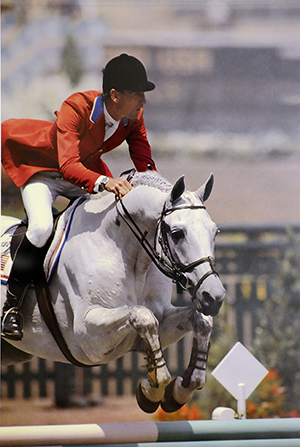
courtesy of the American Trakehner Association
Trakehner horses are the oldest of warmblood breeds, with a studbook dating to 1732. They have been systematically "engineered" for performance--first as cavalry mounts in East Prussia, later as the refined sport horses that have gained the Trakehner breed its international acclaim.
King Friedrich Wilhelm I of Prussia, the father of “Frederick the Great,” saw the changing face of war required a lighter horse, more comfortable to ride over long distances, with more endurance and speed than the heavy horses previously needed to carry armor and haul military equipment. So he chose the best horses from seven of his royal breeding farms, and in the early 1700s moved them all to the new Royal stud at Trakehnen, East Prussia. Through careful crossing of those horses with a hardy native horse called “Schweike” and adding only English Thoroughbred or "oriental" blood, a horse of nobility, elegant movement and great endurance was developed.
Almost 300 years later, strict selection and performance continue to be the hallmarks for today’s Trakehner. The smallest in number of other warmblood breeds, Trakehners are used as refiners for other breeds, resulting in a much higher Trakehner presence than is evident in registrations. For example, Blue Hors Matine, winner of the individual Silver and Bronze medals in dressage at the 2006 World Equestrian Games in Aachen, was sired by Trakehner stallion Silvermoon but registered as Danish Warmblood. Similarly, KWPN-registered Totilas, holder of three Gold medals in dressage from the 2010 World Equestrian Games in Kentucky, was sired by Trakehner stallion Gribaldi out of a Dutch Warmblood mare.
Read more: Introducing the Trakehner: The Oldest of Warmblood Breeds
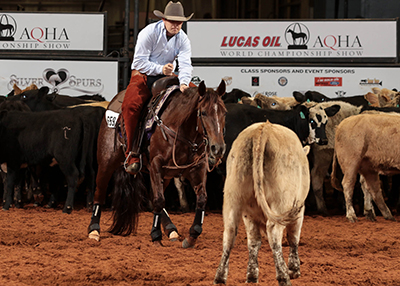
If you have ever seen a horse in one of rodeo’s timed events, enjoyed a leisurely trail ride, watched a Western on the big or small screen or have just seen a group of horses grazing in a pasture, nine times out of 10, you have seen an American Quarter Horse.
These heavily muscled, compact horses were called Celebrated American Quarter Running Horses by English colonists in the 1600s because the horses could run a short distance over a straightaway faster than any other horse. Known for outrunning any horse at the quarter mile, the American Quarter Horse gained popularity. The quarter mile is still the most popular distance for racing American Quarter Horses, and the best blaze the 440 yards in 21 seconds or less.
Whether working cattle on a ranch, taking their owners for a trail ride on a Sunday afternoon or competing in a variety of disciplines, American Quarter Horses are known for their versatility and good temperament. The American Quarter Horse succeeds maneuvers required in reining, working cow horse, barrel racing, cutting, roping and other western events. The American Quarter Horse also excels in English disciplines, including dressage, driving and jumping.
Read more: Profiling the American Quarter Horse, A Very Versatile Breed
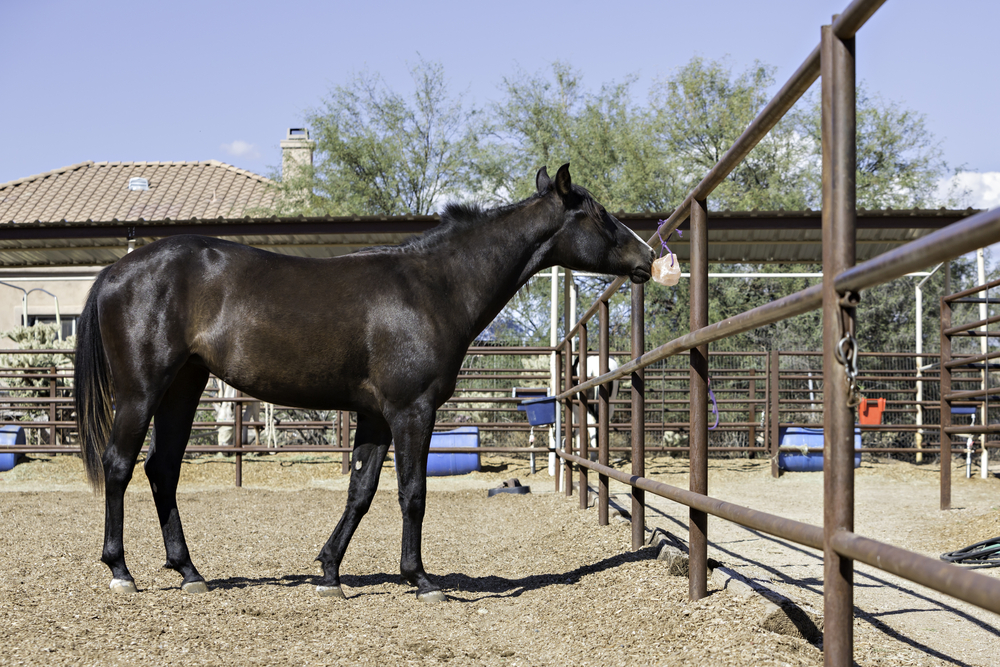
There’s an increasing variety of horse feeds available, but while choice is a good thing, selecting the right feed, or blend of feeds among the options available can be confusing.
This guide looks specifically at balancers to give you an insight into what they are, how to use them and their benefits, so that you can make an informed choice.
What are balancers?
Balancers are small, nutrient dense feeds (often pellets) formulated to provide a concentrated source of vitamins, minerals and quality protein alongside a negligible level of energy (calories). Depending on the horse feed balancer you choose, they may also contain added functional ingredients such as probiotic live yeast or glucosamine.
Read more: Small but Mighty! See the Benefits of Feed Balancers
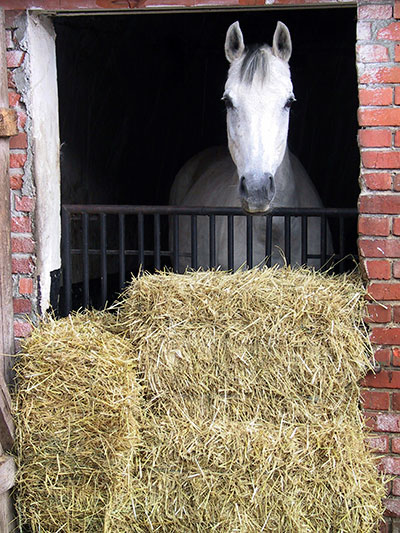
by Sally Flis, Ph.D., Feed and Crop Support Specialist, Dairy One
Chemical analysis of your hay or hay you are going to purchase is an important part of feeding it, but there is quite a bit you can get from a physical inspection of the hay that will give you an idea of the quality of the hay. There are 6 things to look at when doing a physical inspection of a hay lot: color, smell, maturity, moisture, leafiness, and weed presence. It is best to open up a bale and dig through it when doing the physical evaluation. If that is not possible then make sure to reach into the bale as far as you can for a sample. Roam around the bales in the lot to see how similar they all are.
Color – A bright green hay indicates that a hay was cut at a relatively early stage of maturity; rapidly and properly cured, with no damage from rain, molds, or overheating during storage. Light green or faded hay is often due to sun bleaching and is generally not a concern for quality. Colors in hay that should be avoided are: Yellow – stems and seed heads in over mature hay will be yellow; Brown – can be over mature hay or heat damage; Black – rain or heat damaged; and Grey or White – heat damage or mold growth.
Smell – Avoid hay with musty or moldy smells. This hay can be less palatable and can indicate other quality problems. This can come from poorly cured hay, rain damage, or poor storage. Hay should not be purchased or fed if you can see mold when you open the bale.
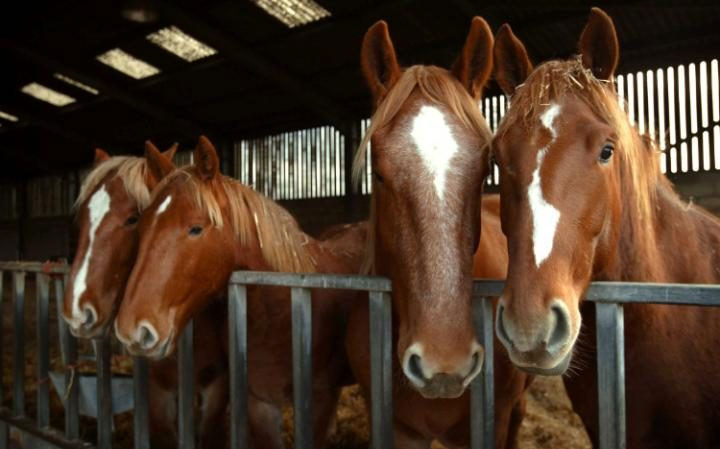
by Patrick Sawer, Senior Reporter, Telegraph UK
Photo Credit: Justin Sutcliffe, Rare Suffolk Punch horses at the Hollesly Open Prison Stud Farm
For centuries they ploughed the fields of England, shaping much of the landscape of East Anglia, before being harnessed for battle during the First World War.
Yet the Suffolk Punch horse - Britain's oldest native breed - is now critically endangered, its numbers in sharp decline a victim of the rapid mechanisation of agriculture.
The plight of the breed – deemed to be rarer than the giant panda or even the Siberian tiger – has moved one landowner to appeal for an organised campaign to save them from oblivion.
If we lost the Suffolk Punch we couldn’t really say we are a nation of animal lovers.
Clare, Countess of Euston, whose estate in Suffolk was once worked by Suffolk Punch horses, said Britain should feel ashamed of itself if it stood by and did nothing to save the breed.
“If we lost the Suffolk Punch I think it would mean we couldn’t really say we are a nation of animal lovers. They are the most magnificent and beautiful of the breeds,” she said.
There are now just 300 Suffolk Punch horses left in the UK, threatening the health and viability of the breed which once formed the backbone of rural life.
Standing sixteen hands high and weighing over a tonne, yet graceful at full gallop, the Suffolk Punch has been described as having “the face of an angel and the backside of a farmer’s daughter”.
Read more: Britain's Oldest Horse Breed in Battle for Survival
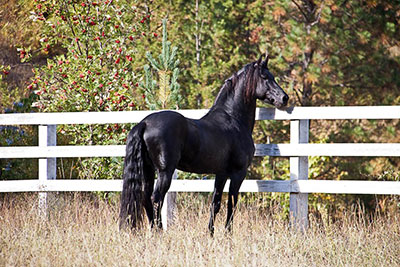
Moriesians: A combination of Friesians (from the dark ages of Europe) and Morgans (from Colonial America).
The Moriesian Horse is the result of a breeding program initiated in the United States to produce horses that combine the elegance and charisma of the Friesian with the versatility of the Morgan. They display an up-headed stature, expressive face, compact body and long thick mane and tail. Their slope of shoulder and movement tends to be more Friesian-like which gives them a regal appearance. Their average size of 15.0 to 16.0 hands makes them comfortable for most riders.
Lighter boned than a Friesian, Moriesians have more of the qualities sought after in a sport horse. The balance and symmetry of this animal is truly art in motion. They make natural show animals that are magnificent to watch, ride and drive. Many have shown themselves to excel in combined driving competitions and have proven apt competitors in classical dressage.
Moriesians are adaptable and eager to perform. Coming from two breeds known for their heart, mild manners, and friendly dispositions Moriesians make wonderful family horses. The breed is honest and willing to please. Its versatility brings lasting value to the owner.
The Friesian horse reportedly dates back 3000 years though the horse we know today was developed in the twelfth century in northern Europe. Friesians were ridden by the Teutonic Knights and used as war horses for the crusades. They could carry large loads, exist on meager rations, and were agile enough to be effective in battle.
- Horsemanship and Behavior
- Akhal-Teke, a Horse Like Shimmering Gold
- Six Ways to Feed Performance Horses for Greater Achievement
- Meeting Increased Summer Hydration Needs
- Meet the American Bashkir Curly Horse Breed
- Joint Prep and Conditioning for Show Season
- Finishing in the Winner’s Circle starts with Purina® Race Ready® Feed
- Why Does My Performance Horse Have a Weak Top Line?
- Bringing Compassion to the Horse Industry
- Horse Tales for the Soul "Never Look a Draft Horse in the Mouth"
- 5 Simple Ways to Increase the Range of Motion in Your Hips
- 7 Equine Emergencies and How to Treat Them
- Equine Therapy 502 (video feature)
- Deworming Medications, Residual Time, and Egg Reappearance
- Accuracy of Testing
- Why should you do Fecal Egg Counts on your Horse?
- Horse Breeds

































